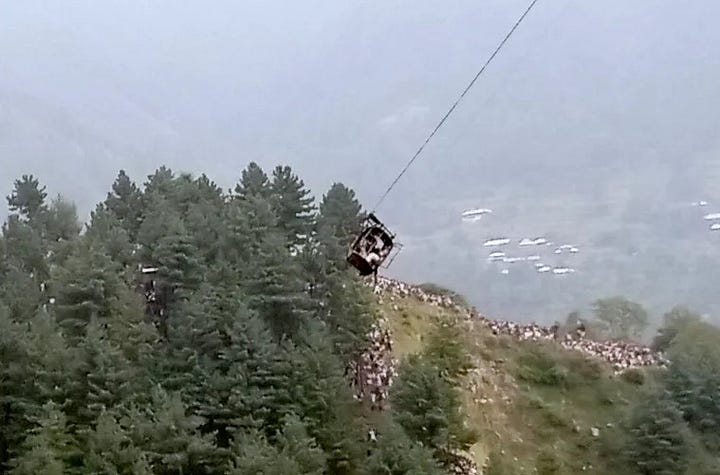
Amidst a tense atmosphere filled with suspense and fear, a gripping rescue operation unfolded in Pakistan to save eight individuals, including six children, stranded in a cable car dangling nearly 275 meters (approximately 900 feet) above the ground.
Taking place on Tuesday, August 22, the operation was labeled as “highly challenging” by the Pakistan Army. Spanning over a period of more than 10 hours, the effort involved the coordinated efforts of multiple helicopters and skilled local zip line experts. The incident occurred when six children and two adults boarded a rickety cable car, referred to locally as a “dolly,” in Pashto village, situated around 60 kilometers (37 miles) from the Battagram district within the northwestern Khyber Pakhtunkhwa province.
This cable car journey was part of their daily routine to reach schools and shops. Tragically, merely five minutes into the approximately 10-minute voyage, two of the three cables supporting the car snapped, leaving the cable car hanging precariously.
Military helicopters were dispatched to the scene, but despite several attempts spanning hours, progress initially eluded them.
Local cleric Mufti Hassan Zaib recounted his presence at the scene throughout the day as the rescue unfolded. “I arrived around midday, alongside numerous other locals waiting for the rescue mission to commence. Some offered their assistance, but they were instructed to wait for the army helicopters,” he shared with Al Jazeera.
Sahib Khan, a resident of nearby Bisham town, arrived at the location with his elder brother Nasir and two colleagues. Called upon by local authorities, the Khan brothers had been operating a makeshift cable car business in the region — a terrain dotted with hills and towering trees. This mode of transportation remained the swiftest means to reach destinations that would otherwise take hours to access.
Despite offering their services upon arrival, they were instructed to await the army’s helicopter-assisted rescue efforts. Nasir, 29, recounted, “We proposed to conduct the rescue ourselves, but were advised to wait. We stayed for four to five hours, but by evening, the army had managed to rescue only one child using their helicopters. Then darkness fell.”
In the dwindling light of sunset, rescue workers successfully extracted the first passenger, 14-year-old Irfan, through a delicate sling operation utilizing a helicopter. His father, Umrez, watched the proceedings with bated breath, expressing profound relief that his son had survived the ordeal.
However, as the realization dawned that the aerial operation could not continue after sunset, hope gave way to anxiety. Nearly 12 hours had passed since the incident, and unreliable mobile phone signals further complicated communication. This was the juncture where the Khan brothers’ team sprang into action.
Images and videos circulated on social media depicted a young man who, along with his brother and colleagues, had ingeniously assembled a smaller, temporary “dolly” using a zip line.
With Nasir operating the pulley from the ground, Sahib, the younger sibling, embarked on the dolly after 7 pm. This marked nearly 12 hours since the initial incident. He courageously navigated his way toward the stranded children, acutely aware that the slightest misstep could result in the loss of seven lives within the cable car, including his own.
Approaching the suspended gondola, Sahib encountered exhausted children barely able to speak. He recalled their shock and their queries about being seemingly forgotten. Tying a rope to the children proved challenging, but Sahib secured himself to his smaller cable car and gradually drew closer, ultimately managing to secure one of the children within the dangling gondola.
Sahib emphasized that the primary challenge was to reassure and calm the children. “They were apprehensive about the movement, but I assured them they were safe with me and that I would take them home,” he stated confidently.

Upon his return with the second child, Sahib observed palpable nervousness among the onlookers, who were fervently praying for the rescue’s success.
“Our dolly was modest in size, and concerns about the weight on the zip line were real. The wind picked up a bit, and the darkness posed challenges. Yet, by the grace of God, we managed to safely bring the second child down,” Sahib recounted.

After Sahib’s successful return, local rescuers took over using the same method to retrieve the remaining four children and two adults. As all eight individuals were safely brought back to the ground, local cleric Zaib, who stood steadfast at the scene until the operation’s conclusion, labeled the rescue a “miracle” while highlighting the ongoing needs of the region.
A former teacher, 28-year-old Zaib expressed that while the rescued eight were fortunate, the same might not hold true for others who frequently rely on the cable car. “We are hopeful that the government will extend assistance. These children are striving for an education; their lives should not be endangered daily,” he stressed.